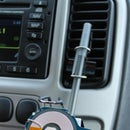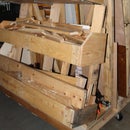Introduction: Perimeter Water Leak Sensor
Here is a simple and low cost implementation of a water leak sensor. It differs from store bought sensors in several important ways:
1. Doesn't rely on batteries that have to be periodically checked.
2. Low cost
3. Sensor surrounds the perimeter around devices/pipes that could possibly leak. A water leak in any direction will trigger the sensor.
This is my entry for the 2017 Sensor Contest.
Step 1: Prototype of Sensor
My basement contains a closet with several water handlers: water filter, water softener, and well pressure tank and lots of valves and pipes. Any of these devices could leak and depending on the slope of the basement floor, the path could be unpredictable. Simple store bought alarms only monitor a single point. My design surrounds the the perimeter with 2 copper foil strips that are about 1" apart. Any water that crosses between the strips will conduct and a simple circuit will trip the alarm
The sensor relies on my hard wired alarm system to activate a siren, email, and call my cell phone.
This design requires only 2 wires from the alarm system (zone voltage and ground). I could have also supplied 12v power from the alarm system but found a clever way to omit power. The Vzone wire is 13.5v when open and supplies 6.87mA when shorted. The alarm will trigger when Vzone is pulled below 3.9v.
I used a termination resistor of 2.2K to force Vzone to 7.1v (this is necessary to tell the alarm there is no wiring fault). I use this 7.1v to power a NPN darlington transistor. When water crosses the copper sensor strips, a small amount of current flows to the transistor base which will cause a much larger amount of current through the collector which pulls Vzone below the threshold 3.9v.
Step 2: Laying Copper Strips
The floor was relatively flat and smooth but I cleaned it anyway with soap and water following the path intended for the copper. I unrolled one copper foil strip from one wall, around the water handlers to a wall at the far end (about 11ft). Curves had to be placed GENTLY to prevent tearing of the foil. Then I ran a 2nd foil strip about 1" apart. The circuit was attached to a nearby stud and a pair of wires soldered to the 2 foil strips.
Step 3: Conclusion
I found that a small amount of water applied by hand would saturate the transistor to 1.4v and trigger the alarm. It takes a few minutes for the water to evaporate enough to raise Vzone above 3.9v.
I haven't had any false positives but since this was installed in the winter with low humidity, the circuit might need to be tweaked to make it less sensitive in the summer if the concrete moisture increases too much.
These were the 2 parts I needed to order:
If this design proves reliable over the summer, I plan on placing a 2nd perimeter around my boiler and hot water tank.
Thanks for viewing my sensor design!

Participated in the
Sensors Contest 2017











